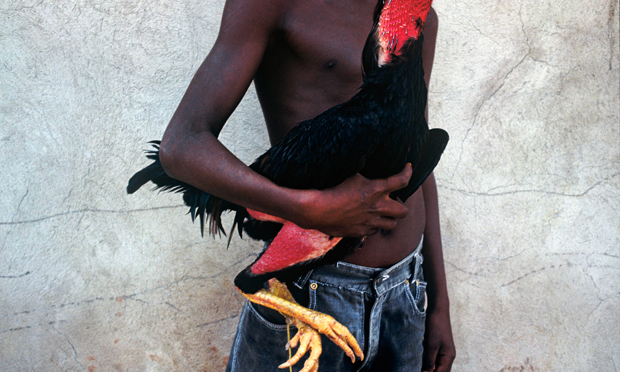
A Serene Expectation of Light, on display at Rivington Place in Shoreditch, offers excerpts from two series of work by Brazilian photographer Mario Cravo Neto.
For over 30 years, before his death in 2009, Neto produced striking images that reflect the complex blend of cultures that give Brazil its unique identity.
The exhibition features the monochrome portraits of the Eternal Now series (produced in the 1980s and 90s) placed alongside Neto’s later colour snapshots of urban life in Salvador, Brazil’s first capital and a centre of immigration and diversity from the first European adventures into South America.
The Eternal Now series profiles aspects of the Candomblé religion that fascinated the artist. Candomblé emerges from the history of Salvador and Brazil, from the mixing of Yoruba, Bantu and Fon beliefs from West Africa with Roman Catholicism and indigenous South American beliefs.
Candomble’s worship of orixás, ancestral spirits imported by the transported peoples from modern Nigeria, Togo and Benin, still provides a rich spiritual and cultural basis for a system of belief and worship that Neto himself embraced during his life. His images here show posed worshippers, objects and animals for sacrifice and ritual moments fixed in black and white.
Neto’s images from this series reflect an almost obsessive focus on the minutiae of human bodies, fine wrinkles and liquid beaded on skin, texture and the interaction between objects and humans.

The studio set-up of these images appears informed by Neto’s earlier practice as an installation artist, the models carefully posed and the images framed for formal effect as much as the impact of their subjects. His images linger on the flick of a feather as a chicken is held, or the congruity of dappled patterning between a tortoise shell and the painted skin of a celebrant.
It is a shame that the installation in Rivington Place has not served these images particularly well, their black and white formality muddied by overly harsh lighting, and the resulting reflections from the heavy glass of the frames. The irritation of this unexpected problem spoils somewhat the first section of the exhibition. From a quick glance at the comments board, I can see that I was not the only visitor to find this frustrating.
Neto’s colour images though, which make up the second section of the exhibition, are well displayed in a double grid of bright squares. These images are still fleshy but more spontaneous, with traces of motion that are absent from the studio portraits of The Eternal Now series. In one of these vivid, less posed images a young woman floats partly submerged in a pool, her body made unfamiliar by the play of light on the water.
Neto’s colour is as stark as his black and white, whether the wet red of watermelon slices in the yellow sun or the deep blue pattern of the tiled street as boys play. Again, textures are the key visual element, an obsessive focus on the contours of surface and body, and the bleed between background and foreground that connotes a passing snapshot of daily life.
The interaction between the two series is well signposted, the exhibition feeling like a brief glimpse into a huge and impressive practice. It contains work by a fascinating artist, whose subjects and life were indivisibly linked.
A Serene Expectation of Light is at Rivington Place, EC2A 3BA until 2 April
autograph-abp.co.uk
